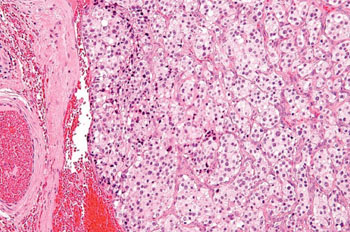Rare Adrenal Tumors Diagnoses Require Blood and Urine Testing
By LabMedica International staff writers
Posted on 24 Jun 2014
Clinical Practice Guideline (CPG) for the diagnosis and treatment of two types of rare adrenal tumors, pheochromocytomas and paragangliomas, has been issued. Posted on 24 Jun 2014
Pheochromocytomas are rare, usually noncancerous tumors that form inside the adrenal glands, while paragangliomas are similar tumors that develop outside the glands and can raise the risk of cardiovascular disease and even death if left untreated.

Image: A photomicrograph of a paraganglioma, a carotid body tumor (Photo courtesy of Nephron).
The Endocrine Society (Washington DC, USA) recommends that initial testing for pheochromocytomas and paragangliomas (PPGL) include blood or urine tests for metanephrines, the products left behind when the body metabolizes epinephrine and norepinephrine. They suggest using liquid chromatography with mass spectrometric or electrochemical detection methods rather than other laboratory methods to establish a biochemical diagnosis of PPGL. The measurements of plasma metanephrines should be done by drawing blood with the patient in the supine position and use of reference intervals established in the same position.
The use of a clinical feature-driven diagnostic algorithm to establish the priorities for specific genetic testing in PPGL patients with suspected germline mutations is recommended. Patients with paraganglioma should undergo testing of succinate dehydrogenase (SDH) mutations and that patients with metastatic disease undergo testing for SDH subunit B mutations (SDHB). At least one-third of all patients with PPGLs have disease-causing germline mutations which are inherited mutations present in all cells of the body. The prevalence of PPGL in individuals carrying a germline mutation in PPGL susceptibility genes may be around 50%. Patients with hereditary PPGLs typically present with multifocal disease and at a younger age than those with sporadic neoplasms. Symptoms of these tumors include high blood pressure, episodic severe headaches, excess sweating, racing heart, feelings of anxiety and trembling.
Jacques W.M. Lenders, MD, PhD, FRCP, of Radboud University (Nijmegen, the Netherlands), and chair of the task force that authored the guideline said, “In addition to the strain these tumors put on the cardiovascular system, between 10% and 17% of the tumors can become malignant. Scientists have discovered that at least a third of people with these conditions have a disease-causing genetic mutation, so early detection can benefit family members who may be at risk.” The study was published on June 3, 2014, in the Journal of Clinical Endocrinology and Metabolism.
Related Links:
Endocrine Society
Radboud University




 assay.jpg)









